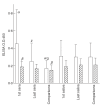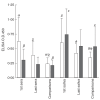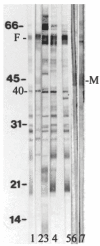Long-term antibody responses following human infection with Campylobacter jejuni
- PMID: 12296859
- PMCID: PMC1906500
- DOI: 10.1046/j.1365-2249.2002.01966.x
Long-term antibody responses following human infection with Campylobacter jejuni
Erratum in
- Clin Exp Immunol 2002 Dec;130(3):564
Abstract
Epidemiological evidence suggests prior infection of humans by Campylobacter jejuni leads to protection against disease following further exposure. It is known that infections elicit strong antibody responses following the onset of disease and that antibody levels are elevated in putatively immune populations. To determine if systemic and mucosal antibodies induced by a confirmed infection remain at elevated levels for prolonged periods, repeat serum, saliva and urine samples were taken from campylobacter patients from 1 week and up to a year postinfection. Antibodies were monitored by ELISAs using three different antigen preparations: acid-glycine extracts (AE) of C. jejuni strain 81116 and an aflagellate mutant (R2), and a whole-cell R2 sonicate, and by Western blotting. Levels of serum IgG antibodies against 81116AE and R2 sonicate, but not R2AE, remained significantly raised over time when compared to a comparison population. Serum anti-sonicate IgA antibody levels were initially significantly raised but decreased over time to levels similar to the comparison group. There were no significant differences in levels of salivary IgA against the AEs. Anti-sonicate salivary IgA and IgG levels were initially significantly higher than in the comparison group. Both declined over time but the IgG levels remained significantly higher. Significant correlations were seen between serum IgG levels and age and duration of illness. Serum antibodies against flagellin, 40 kDa and 29 kDa antigens were still detectable in most patients up to a year postinfection, as were salivary antibodies to flagellin, the major outer-membrane protein and a 40 kDa antigen.
Figures

 R2 AE.
R2 AE.

References
-
- Tauxe RV. Epidemiology of Campylobacter jejuni infections in the United States and other industrialized nations. In: Nachamkin I, Blaser MJ, Tompkins LS, editors. Campylobacter jejuni: current status and future trends. Washington, DC: American Society for Microbiology; 1992. pp. 9–19.
-
- Newell DG, Nachamkin I. Immune responses directed against Campylobacter jejuni. In: Nachamkin I, Blaser MJ, Tompkins LS, editors. Campylobacter jejuni: current status and future trends. Washington, DC: American Society for Microbiology; 1992. pp. 201–6.
-
- Black RE, Perlman D, Clements ML, Levine MM, Blaser MJ. Human Volunteer Studies with Campylobacter jejuni. In: Nachamkin I, Blaser MJ, Tompkins LS, editors. Campylobacter jejuni: current status and future trends. Washington, DC: American Society for Microbiology; 1992. pp. 207–15.
-
- Russell RG. Campylobacter jejuni colitis and immunity in primates: Epidemiology of natural infection. In: Nachamkin I, Blaser MJ, Tompkins LS, editors. Campylobacter jejuni: current status and future trends. Washington, DC: American Society for Microbiology; 1992. pp. 148–57.
Publication types
MeSH terms
Substances
LinkOut - more resources
Full Text Sources
Medical
Molecular Biology Databases
Miscellaneous

